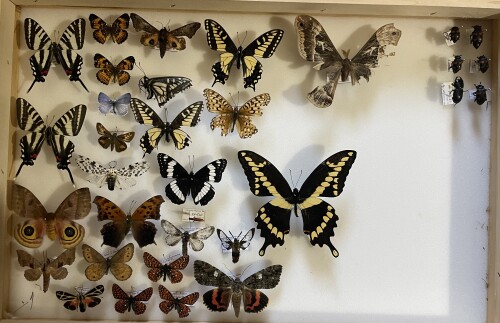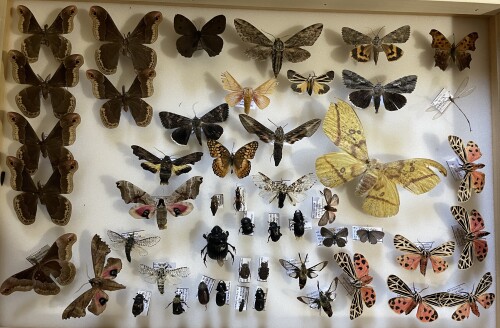have been working on "preparing-up" lately. Here in the
U.S. late summer is upon us. Some broods have already
ended whilst others are on their 2nd or 3rd go around.
I'm mostly a lepidopterist but, when opportunity knocks
at capturing something nifty I jump at the chance.
I thought I would show some of my latest captures along
with some insights into their preparation.
Common Sulphur (Colias philodice) (male)

This species has been slowly making a presence these
last 3 weeks. Prior to that only cabbage butterflies were
present as Pieridae in the upper midwest region. Both
males and females are gaylee colored in a bright sulphur
yellow along with a much lesser occuring "white form"
female.
I find these VERY easy to work with generally. A 20-25 min.
stay in the kill bottle is all it takes and they remain soft and
pliable to work with. I find that small square glass strips with
polished/beveled edges work well at keeping wing margins
nicely flat. Tracing paper strips work well too.
Pearl Crescent (Phyciodes tharos) (male)

This species has at least 3 if not 4 broods in my region. When
they do emerge they all seem to emerge within a matter of days.
When they are present their are usually LOTS of them for a
couple weeks and then --- all gone. Lovely little species really
with a fair amount of variation.
Small fry such as these (or smaller) receive a diffrent treatment
in preparation by me. I found that glass slides of any kind tend
to TOO easily remove scales (even causing wing mars) in their
own right. So, instead I dispatch my small captives and 20 min.
in the kill jar is all you need. Then I pin them using a fine 00 or
000 size insect pin. Nothing larger should be used so you don't
break the specimen in half or otherwise lose most of the legs !
Wing manipulation is done using another fine pin placed (under)
each wing at an angle and "lifting it up" in a smooth movement.
Nearby, I have a a small rectangle of tracing paper with a 00 pin
placed in it. As I move each wing in place my other hand places
the (pinned rectangle scrap) over a portion of the wing to hold
it fast in place. I set the left forewing then the right forewing.
I then set the left hindwing followed by the right hindwing. The
head/antennae then follow with the abdomen finishing up the task.
I feel I've gotten pretty adept at working with these smaller leps
using my technique so, I'm pretty pleased at adding new additions
whenever possible...
Eastern Tailed Blue (Everes comyntas) (female)

This species is common and widespread and yet getting
good ones is not so easy. I have at times caught 6 or 8 in
an outing only to get home and find 1 or 2 worth keeping.
Tails are easily lost and wings are either chipped or marred.
Though smaller than the previous Pearl Crescent I still employ
the same careful, delicate wing-maneuvering and hold-fast
placement of tiny strips for success. Again, specimens this size
should be VERY fresh for ease of preparation !
Reddish-brown Stag Beetle (Pseudolucanus capreolus)(female)

Coleoptera are not the usual suspects on my "hit" list while in
the field but, those that do bring attention to themselves for
size, color, or uniqueness are not passed up.
Naturally, a species that's generally awesome in appearance needs
to look that way in its presentation (my humble opinion). So, items
like this are assured a life-like pose by my guiding hand.
In the photograph, I have deliberately left most of my pin placements
there to be seen although, I did remove pins placed at the mandibles,
maxillary palps, and antennae for ease of viewing.
A recent practice employed by me (within these last 2 years) involves
the placement of the PRIMARY pin in the scutellum of the beetle rather
than the right wing cover. This method was first noticed by me a couple
years back when a certain accomplished master preparator AND member
(Panacanthus) produced photographs of some of his fine coleoptera NOT
"sporting" pins in the right-wing covers. It was an epiphany for me !
What an improved look to beetle preparation.
I call it the "Panacanthus Method".
So far, the results have been very pleasing !
Polyphemus Moth (Antherea polyphemus) (female)

One of eastern North America's largest and best known giant silk moths.
I recently received some cocoons of bred stock from a member here. I
have always had an appreciation for Saturniidae but, it has become
very much harder in recent times to find much in the way of "wild"
cocoons.
Large species such as this are generally the easiest to work with and
prepare however, in the case of moths they oftentimes have a fine
carpet of hair present nearest the body and somewhat "coating" the
hindwings and partial forewings. These hairs are long hollow tubes.
When paper strips or glass strips are laid across this coating of hairs
and TOO much pressure is applied to hold them down then what
you get are very prominent vertical "lines" where the hairs have been
crushed all along the edge.
What I've learned to do over the years is only use my glass strips
along the wing margins initially to only hold the wings position
temporarily. I then place a medium-width strip near the base of
the wings and yet only enough to provide tension but, not overt
pressure. Notice that my pins placement is a little distance
from the wing margins. I then remove the glass strips holding down
the wing margins and I then place a 2nd wide strip where the
glass strips were. Again, to provide TENSION and not so much
pressure.
This method has allowed me to acquire many fine fur-covered
saturniids free of vertical pressure "lines" present in the wings.
So, these are just some of my activities as of late although, I
have numerous other specimens on the boards. However, I just
wanted to show some of the variance of my latest captures as
well as passing along some subtle insights learned thru my
years of insect preparation/presentation.











